Besöket i Petra gjordes under en pressresa tillsammans med Jordan Tourism Board och Royal Jordanian Airlines, men alla tankar och åsikter är som vanligt mina egna.
I Jordaniens karga ökenlandskap, bland rosaröda sandstensklippor och trånga raviner, ligger ruinerna efter en av världens mest fascinerande städer. För 2000 år sedan var Petra en av mellanösterns rikaste handelsstäder, men när landets politiska center flyttade norrut under 700-talet flyttades även de inkomstgivande handelsvägarna. Petra övergavs och lämnades åt sitt öde.
Genom århundradena glömdes den avlägsna ökenstaden bort av alla utom områdets beduiner, som övertagit området och skyddade stadens hemligheter. Det var inte förrän i slutet av 1800-talet som platsen blev återupptäckt för omvärlden och ryktet om den storslagna sagostaden började spridas.
Idag är Petra ett världsarv och utnämnt till ett av världens moderna underverk. En plats med massor av sevärdheter att upptäcka, uppleva och utforska över flera dagar. Jag besökte Petra i en dag och en kväll, vilket bara skrapade på ytan till denna magnifika stad.


Vattencisterner och handelsvägar
Staden Petra grundades av nabatéer år 600 före Kristus. Nabatéerna var ett nomadiskt arabfolk med stort kunnande om handel, livet i öknen och om hur man samlar och förvarar dricksvatten. Att bygga en stor stad mitt i ett ogästvänligt landskap kanske låter som en utmaning, men platsen var väl vald. Här möttes flera av dåtidens stora handelsvägar mellan Kina, Arabiska halvön och Egypten och flödet av exotiska varor och kryddor var stort.
För att göra staden attraktiv för besökare och för att möjliggöra ett liv i öknen krävdes dock tillgång till vatten, ett problem som nabatéerna hade lösningen på. Under sommarhalvåret utsätts området kring Petra för extrem värme och torka, men under vinterhalvåret faller stora mängder regn. Genom ett avancerat system av vattenkanaler och akvedukter kunde vinterns regn samlas in i stora cisterner under jord och Petra blev en grönskande och välmående stad i ett ogästvänligt landskap.

Det är lätt att tro att Petra är synonymt med den kända byggnaden Skattkammaren (Al-Khazneh), men Petra är lämningar efter en hel stad och en civilisation med marknadsplatser, tempel, gravar och bostäder. En stad där 30.000 människor en gång i tiden levde och verkade. Staden sträcker sig över en yta lika stor som fyra Manhattan och sedan de arkeologiska utgrävningarna påbörjades i början av 1900-talet har bara några procent av staden hittills blivit utgrävd. Inskriptionerna är få och staden rymmer än idag oändligt många fler frågor än de som hittills blivit besvarade.

Bab al-Siq
Det är tidig morgon när vi börjar vår vandring till Petra, en sträcka på ungefär 2 kilometer från besökscentrum till det första riktiga stoppet vid Skattkammaren. Temperaturen har närmat sig nollgradigt under natten och jag är tacksam för att jag packat med mig både fleecejacka och vindjacka.
Den första halvan av sträckan går på en bred väg genom Bab Al-Siq, ett stenigt område med flertalet byggnader, gravar och lämningar som de flesta turister passerar förbi lite för snabbt i sin iver att få en bild av Skattkammaren utan horderna av turister.
En av de platser som är värd att stanna till vid innan du når ravinen Al-Siq är Obeliskgraven, en familjegrav karvad i klippväggen kring år 100. Toppad av fyra pyramidliknande obelisker samt krönt av en vindpinad staty är arkitekturen tydligt inspirerad av både grekiska och egyptiska besökare.



Genom ravinen Al-Siq
En spricka öppnar upp sig i berget framför oss. Al-Siq är en imponerande ravin, omfamnad av rullande mjuka klippväggar i toner av bränd jord. Ingången kantas av resterna av en valvbåge som efter 2000 år rasade under en jordbävning i slutet av 1800-talet. En påminnelse om att området är en levande plats som fortfarande formas och förändras.
Al-Siq är inte en ravin skapad av vattnets rörelse, utan en naturlig spricka i berget. Det här var huvudleden för de forntida karavanerna in till staden och många fötter och hovar har under åren passerat på den stenlagda vägen. De vågiga väggarna närmar sig varandra ju närmare vi kommer Skattkammaren och när det är som smalast kan jag nästan nå mellan väggarna när jag sträcker ut händerna.



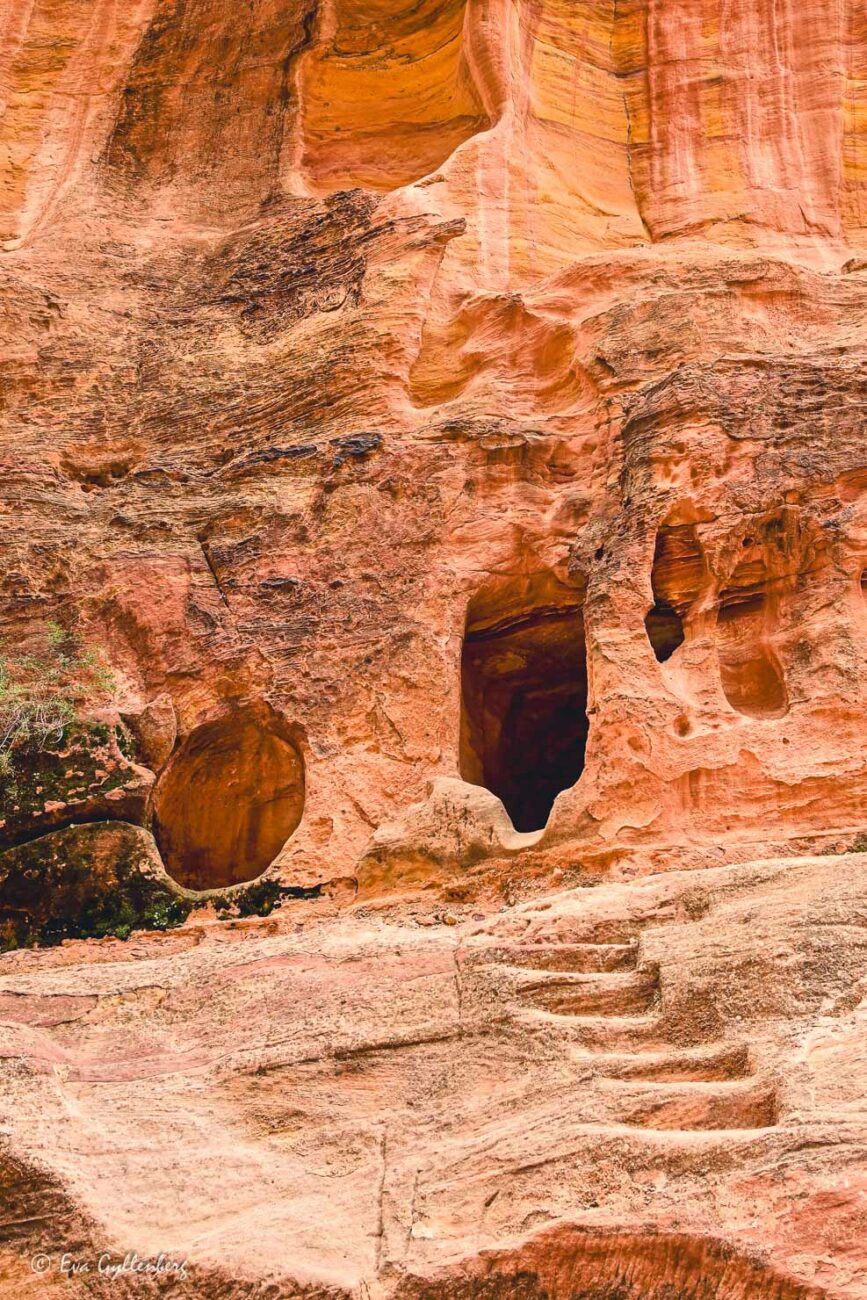
Al-Siq är inte bara en dramatisk handelsväg för att nå Petra. Längs vägen möts vi av eroderade statyer, små tempel och karvade väggnischer. Platser för reflektion och tillbedjan för de forntida besökarna och en helig pilgrimsled för nabatéerna.
Klippväggarna reser sig upp till 80 meter ovanför mitt huvud och trots avsaknad av sol hindrar det inte ett ensamt fikonträd att bära frukt. Ett minne av den grönskande och levande stad som Petra en gång var.


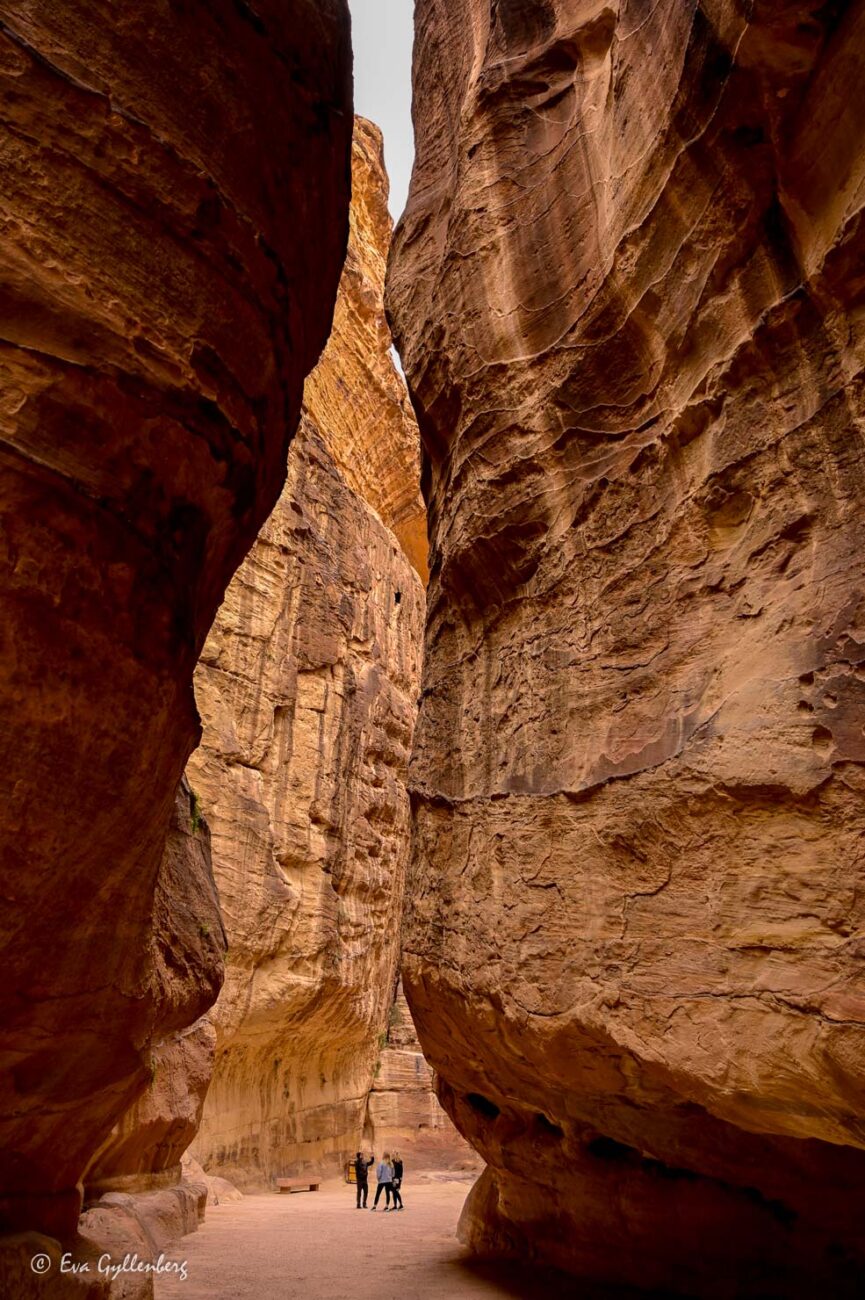
Längs ena klippväggen rinner vatten i en ränna av terrakotta. En av alla avancerade lösningar för att ta tillvara det regnvatten som sipprar ner längs ravinens väggar under vinterhalvåret. Men även om vattnet var livsnödvändigt under Petras glansdagar, är det idag en förbannelse för de som försöker skydda Petra för framtiden.
Stenfötter av en kamel och en man i särk är det enda som finns kvar idag av den stora statyn av en kamelkaravan i Al-Siq. Erosion av vind och vatten sliter hårt på stadens monument och det är en ständig kamp för att lyckas bevara det som finns kvar för världen. Lägg dessutom till komplexiteten i att det förväntas komma 1 miljon besökare till Petra år 2023. Att jämföra med en handfull besökare per dag för tjugo år sedan.

Efter drygt en kilometers vandring genom ravinen ser vi den första glimten. För varje steg vi tar öppnar sig klippväggarna lite till och plötsligt står jag framför en av världens mest kända historiska byggnader – Skattkammaren.



Skattkammaren – Al-Khazneh
Det är svårt att inte bli hänförd av synen av Petras mest kända byggnad Skattkammaren. Ofattbart vacker och så unik. En byggnad som inte alls är byggd, utan helt karvad ur en klippa. Trots områdets många och svåra jordbävningar under de senaste 2000 åren, har denna rosaröda fasad stått emot tidens tand och detaljerna som möter besökarna än idag är imponerande.
Enligt senare tidens arkeologiska utforskningar var Al-Khazneh antagligen varken en skattkammare eller ett tempel. Byggnaden tros ha skapats kring år 100 före Kristus som ett mausoleum för en kunglighet. Tack vare skisser från områdets första arkeologer under 1800-talet har man lyckats fylla i detaljer som idag har eroderat bort. På var sin sida av ingången står resterna av två statyer av män till häst. Dessa anses vara Castor och Pollux, tvillingbröder i den Grekiska mytologin. Den kvinnliga statyn i rotundans centrum anses vara den egyptiska gudinnan Isis, en viktig gudinna i alla riter som kretsade kring döden och de döda. En passande gudinna vid ett mausoleum.


Vi är definitivt inte ensamma framför Skattkammaren, trots att det är tidig morgon. Turisterna väller in och försäljarna skriker ut sina erbjudanden om kamelturer, betalda utsiktsplatser och beduinhalsband. Men trots allt folk har jag bara ögon för Skattkammaren. Den här platsen suger in mig, förtrollar mig och tar andan ur mig. Ett riktigt bucket-list-moment.
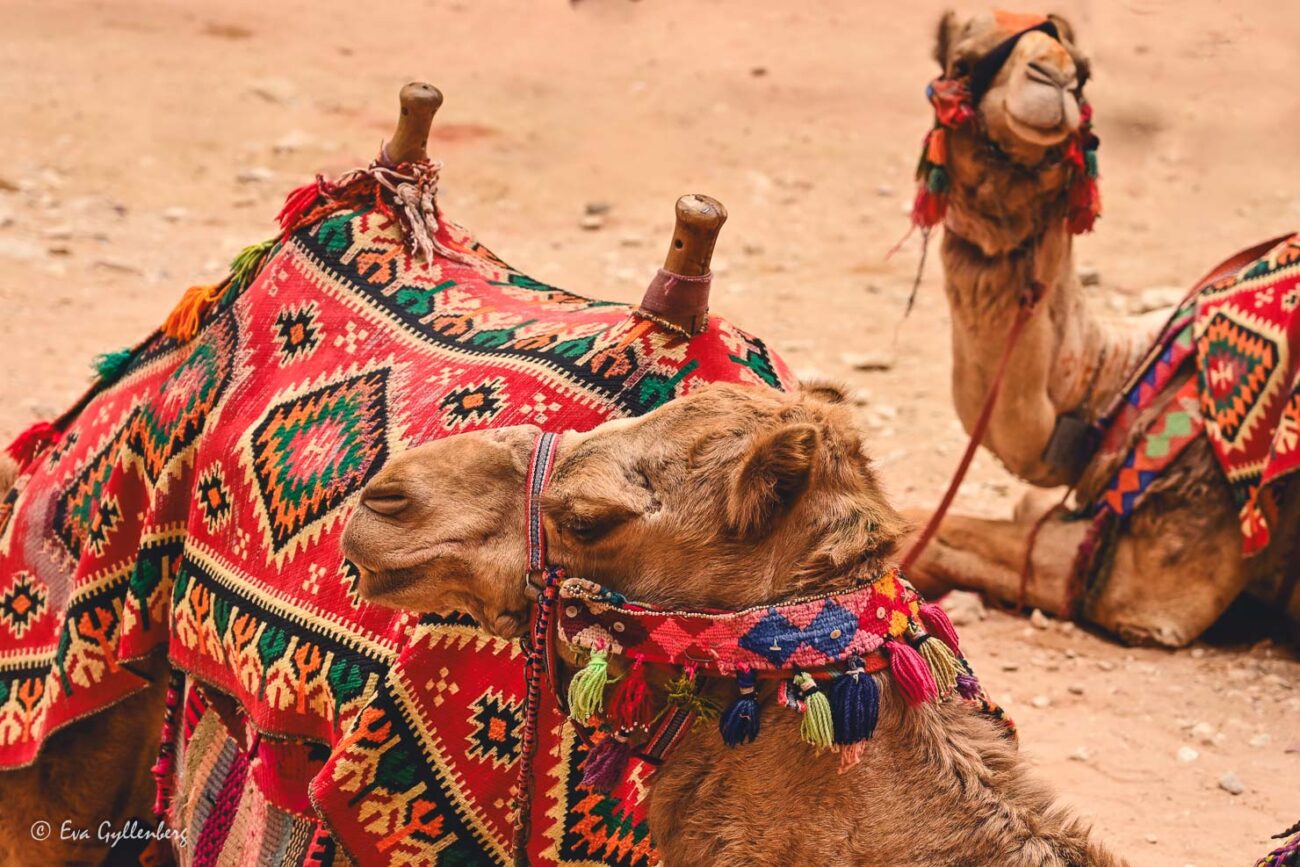


Kungliga gravarna och Fasadgatan
Från Skattkammaren fortsätter huvudleden in i staden Petra på den så kallade Street of facades – Fasadgatan. Vägen är nu bredare och stora gravar med höga stenfasader ligger på rad.

Innan vi kommer fram till teatern svänger vår guide höger och tar med oss upp på en mindre stig upp på berget till De kungliga gravarna – The Royal Tombs. Egentligen vet ingen om detta är kungagravar, men de som byggde dessa gravar var utan tvekan inflytelserika och hade gott om pengar.
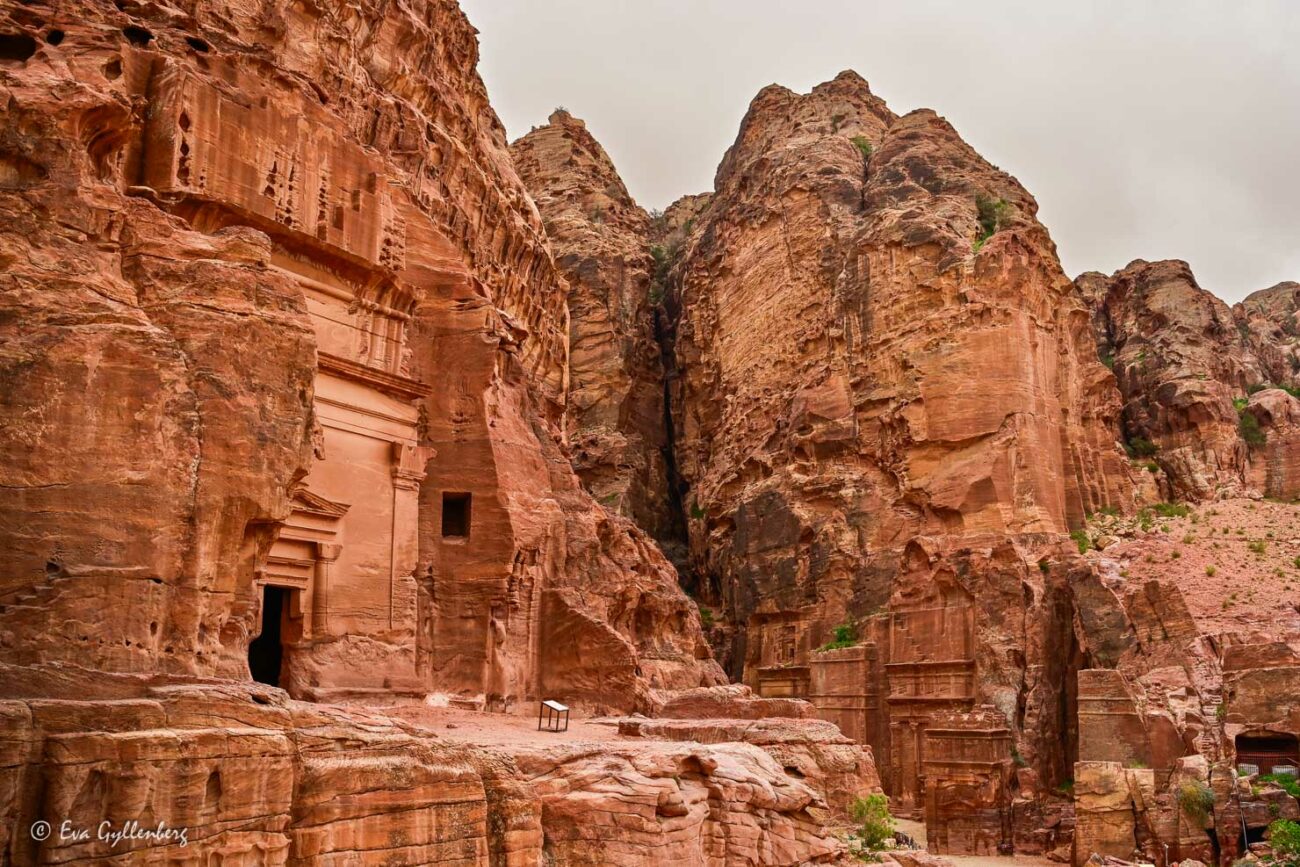
The Royal Tombs är ett område ovanför huvudgatan med en stor mängd pampiga gravar med höga stenfasader. Vissa av gravarna har en gång i tiden varit minst lika utsmyckade som Skattkammaren, men här i utsatt och öppet västerläge har naturen slitit ner fasadernas detaljer.


De mest kända gravarna är Urngraven, Korintergraven, Palatsgraven och Silkegraven. Till skillnad från Skattkammaren kan du här gå in i de tomma gravkammarna. Den mest imponerande graven är Urngraven, där det perfekt fyrkantiga rummet har stenväggar som skiftar i olika röda nyanser. Det känns nästan som att stå mitt i en vild eldsvåda, där de roströda färgerna i stenen dansar som eldsflammor på väggarna.




Det rasar ner några stenar från klipporna bredvid mig. En hord av getter slänger sig orädda mellan branternas smala avsatser. När Petra blev ett världsarv 1985 så tvingades de beduiner som bodde i området att flytta ut, men vissa beduiner valde att stanna kvar i grottorna och fortsätta leva sitt traditionella liv. Men det går inte att leva på enbart boskap längre, nuförtiden är turismen huvudinkomsten.
I en av de naturliga grottorna nedanför kungagravarna sitter en man och säljer traditionellt te och läskedrycker. Grottans golv är täckt av handknutna mattor och tekittlarna kokas över öppen eld. Att dricka sött te tillsammans är något av en ritual som beduinerna gör varje dag och de bjuder gärna in besökare till en kopp. En beduin som vi träffade senare under resan satte ord på känslan. ”Hur jobbigt än livet är eller vad som än händer i världen, kan man alltid sätta sig ned och ta en kopp te”.


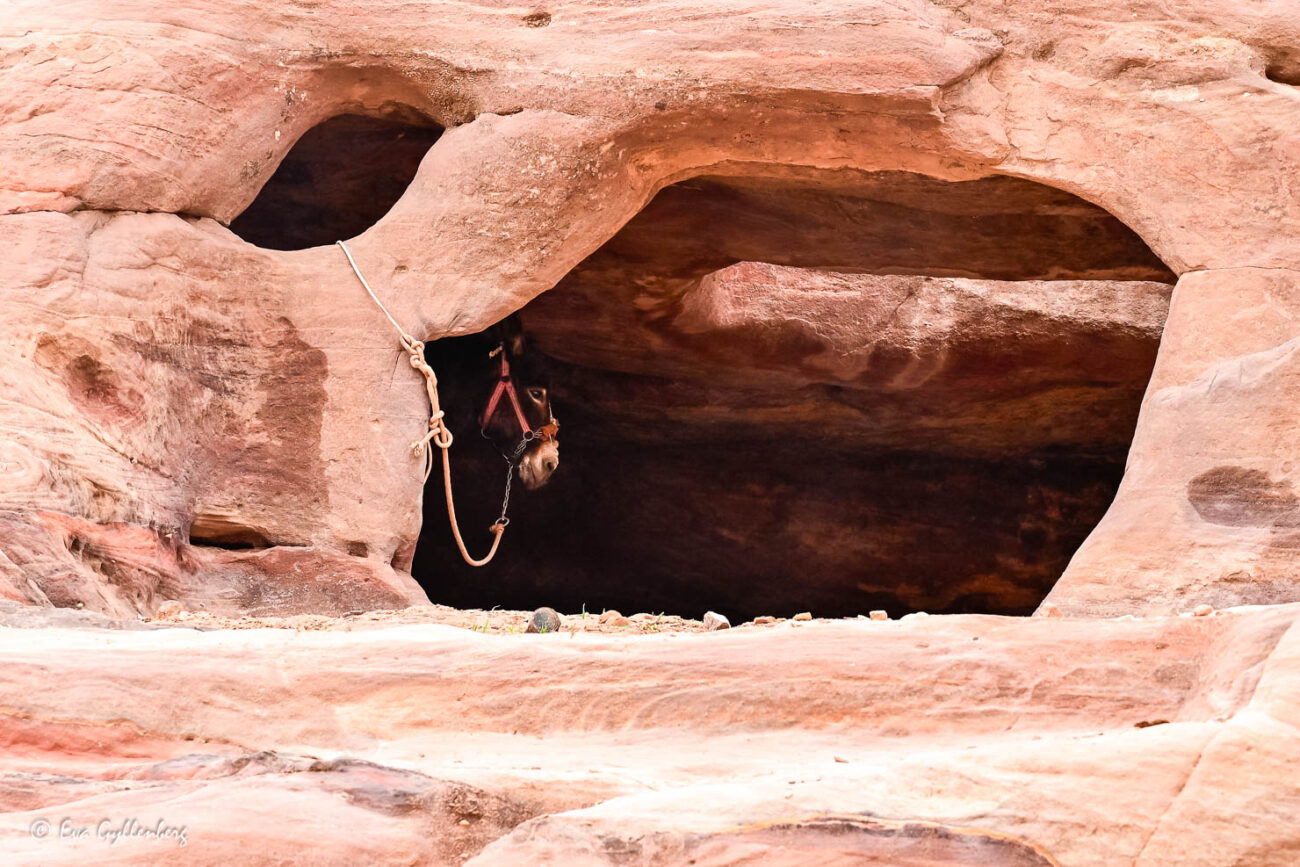
Pelargången och Qasr al-Bint
Jag tar mig ner på små stigar från de kungliga gravarna på höjden och når snart huvudgatan och Pelargångsgatan – The Colonnaded Street. Byggd av romarna som tog över Petra år 106 och en gång i tiden hjärtat av staden. De flesta av de stora pelarna som en gång i tiden kantade gatan står inte längre kvar, men några gamla stenpelare sträcker sig fortfarande mot himlen. Det är lätt att föreställa sig en livlig, romersk stad i detta dramatiska landskap.

Många år innan Petra utvecklades till en viktig handelsstad, byggdes här ett tempel i korsningen av två karavanleder – Qasr al-Bint. Petra kanske upplevs på ytan som en stad byggd av grottor, men egentligen hade Petra tusentals vanliga byggnader. När staden blomstrade som mest fanns här grönskande trädgårdar, stora tempel, romerska villor och lyxiga fontäner. Till skillnad från de beständiga gravarna och grottorna, har dock de flesta av stadens vanliga byggnader raserats vid jordbävningen år 363 efter Kristus. Under några skälvande minuter förstördes nära hälften av alla byggnader i Petra. Qasr al-Bint är en av de få byggnaderna som överlevt, om än i ett skadat skick.
Bredvid Qasr al-Bint ligger resterna av en stor byggnad som inte klarade jordbävningens kraftiga attack. The Great Temple – en byggnad av religiös betydelse, men antagligen inte ett tempel. De stora pelarna som formade byggnadens kropp har fallit och de cylindriska stenblocken ligger på varandra som ett utmanande plockepinn.


I slutet av huvudgatan hittar du vandringsleden till en annan av Petras mest kända gravar – Klostret – Ad-Deir. Ad-Deir är en av Petras höjdpunkter och byggnaden påminner om en större version av Skattkammaren. Enligt vår guide skulle den medelsvåra vandringen på 3 kilometer (med 800 trappsteg) ta 2 timmar fram och tillbaka, vilket det helt enkelt inte fanns tid till under mitt besök. Petra sträcker sig över ett väldigt stort område och om du bara har en dag på dig så kommer du att behöva prioritera hårt.



Teatern i klippväggen
Det börjar bli dags för mig att bege mig tillbaka till den väntande bussen. Från slutet av pelargången till ingången till Petra är det en fyra kilometer lång promenad tillbaka till ingången, en promenad som tar längre tid än man tror. Mängden störande element som turister, åsnor, kameler, försäljare och sevärdheter drar ner tempot rejält.
På Fasadgatan stannar jag till vid Petras stora teater. Den enda romerska teater i världen som är helt uthuggen ur en klippa. Ursprungligen hade teatern plats för över 5.000 åskådare, men under romarrikets styre byggdes teatern ut genom att hugga bort de gravar som tidigare låg ovanför. Det är en spännande att visualisera de 8.500 människor som satt här i publiken för 2000 år sedan, fullt uppslukade av ett drama eller ett musikframträdande.

En unik plats
När jag passerar förbi Skattkammaren på vägen ut hinner jag knappt stanna till, men jag tar en sista titt på områdets stora sevärdhet. Hur länge kommer vi att kunna skydda denna skatt för framtida generationer? Jag lägger försiktigt in bilden av Petra i ett väl valt minnesfack i min livshistoria, med vetskapen om att Skattkammaren aldrig någonsin kommer att kunna bli vackrare än den är just idag.

Petra by night
Tre dagar i veckan körs ett event i Petra kallat Petra By Night. Det är separat inträde till detta event och biljetter köps kontant i kassan vid ingången (17 JD). Under eventet tänds ljus i papperslyktor längs med hela Siq och väl framme är det någon typ av underhållning och ljusshow. Skattkammaren lystes upp av grälla neonfärger och underhållningen bestod i flöjtmusik i några minuter och sedan en man som läste något ohörbart. Gå på Petra by Night om du vill uppleva Siq i skenet av stjärnorna och tusentals ljuslyktor, men förvänta dig inte någon fantastisk ljusshow à la Las Vegas vid Skattkammaren.




Var ligger Petra?
Petra ligger i sydöstra Jordanien, cirka 3 timmar med bil från Amman. Närmaste stad är Wadi Musa, där det finns flertalet hotell och restauranger. Jag reste hit på en rundresa med buss, men det går även att boka dagsutflykter från exempelvis Akaba.
If you see this after your page is loaded completely, leafletJS files are missing.
Vad kostar det att besöka Petra?
De allra flesta besökarna till Petra köper Jordan Pass – ett mycket populärt turistpass med inträde till Petra och 40 andra sevärda platser runt om i landet. Ett Jordan pass med två dagars inträde till Petra kostar 75 JD (cirka 1200 SEK), att jämföra med en enskild 2-dagarsbiljett till Petra för 55 JD (cirka 850 SEK).
3 Tips inför ditt besök
- Lägg två hela dagar i Petra. Då hinner du även se The Monastery och några av utsiktspunkterna utan stress. Petra by Night hade jag skippat.
- Ta på dig stabila skor. Jag hade med mig joggingskor – vilket fungerar bra på de flesta ställen, men om du vill gå några av lederna över klipphällarna är det bra med stabila skor. Speciellt viktigt med bra skor är det under Petra by Night, då det är lätt att stuka fötterna i mörkret på en väldigt ojämn väg.
- Det är kallt under vinterhalvåret, så skippa sommarklänningen och satsa på fleecejacka/vindjacka istället.









